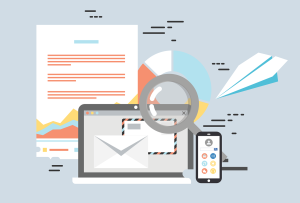Personalized Marketing: Unlocking the Power of Direct Marketing
Get Started
Call-to-action
Tel: (+234) 802 320 0801, (+234) 807 576 5799
Email: info@Stonehillresearch.com
Office Address: 5, Ishola Bello Close, Iyalla Off Street, Alausa, Ikeja, Lagos, Nigeria
Executive Summary
In the contemporary world where getting attention has become very hard, personalized marketing is one of the best ways through which businesses can attract attention coupled with the best ways through which a business can bond with customers. This white paper explores the efficiency of customer segment-specific direct marketing communications like email, SMS, and direct mail.
When messages are personalized to the relevant people and their needs, there is increased touch point engagement meaning increased rates of conversion making the entire marketing effort more cost-effective and thus, yielding better returns.
Addressed marketing makes it easier for organizations to retain clientele, and this provides business organizations with a competitive advantage.
Introduction
Direct marketing is a form of selling where a product or service is advertised to customers, bypassing intermediaries, for example by email, SMS, or post. Because of the growing concern of customers regarding more personalization, the chances of increasing the efficiency of direct marketing campaigns have increased today. When clients use targeted messaging, then they will be reaching out at the correct time with material that a client will find useful at that time thus leading to conversions.
Importance of Personalized Direct Marketing
In a rather crowded environment for business advertising, customers receive numerous generic messages and offers, thus, personalization would be of great benefit to businesses.
Targeted marketing approaches to customers and audiences provide great opportunities for successful marketing messaging since it lets businesses address their audiences and customers personally.
This approach makes the existence of a closer bond and develops trust thus the chances of the customer opening the message and relating to it are high.
Benefits of Personalized Direct Marketing
Increased Conversion Rates
Mail targeting is more effective than broadcasting to customers as it addresses their style of need, wants, and wealth. When it’s personalized to the consumer, the product offers recommendations, and messaging help to prompt the customer to perform the desired action, such as a purchase, subscription, or interaction.
Improved Customer Engagement
To be more precise, with the help of serving the right content to the right audience at the right time, companies can enhance customers’ engagement dramatically. This mode of communication grabs attention more than the general broadcasts and helps generate higher open rates click – through rates and response rates for email, SMSs, and even direct mail.
Enhanced Customer Loyalty
People like to get services that respect their demands and tastes. Customer loyalty can be built by ensuring that the firm delivers individualized experiences repeatedly since the customers feel appreciated and closer to the brand. This results in repeat custom and customer recommendations to friends and family members etc.
Better ROI
Personalized marketing increases the effectiveness of a campaign so that businesses can gain better results with less effort. Thus, by reaching out only to those customers who are interested in the content businesses can also minimize wastage and enhance ROI.
Competitive Advantage
When there are so many similar competitors, organizations adopting personal direct selling can distinguish themselves in the market. Personalization makes a brand more appealing and allows a brand to stand out from others, and show the consumer that they are valued.
This is possibly the best time for businesses to harness the beauty of personalization in their direct marketing to make the campaigns more effective, influential, and profitable.
Channels for Personalized Direct Marketing
Email Marketing
Segmentation and Targeting
Underlying the approach to email marketing is the classification of the audience by simple parameters such as demographic, purchasing, and activity indicators. This enables organizations to communicate more targeted messages to those customers that would be of interest to them.
Customer Personalisation – Content and Deal
The recipient can send an email to the customer by their name, using the product preferences or previous shopping history the recipient has with the company. It increases the pertinence of the message being delivered hence increasing its effectiveness.
Automation and Triggers
The use of marketing automation enables organizations to send tailored emails using such opportune stimuli as cart abandonment warnings, post-purchase follow-ups, and customer anniversaries. That way information dissemination is timely and relevant.
Metrics and Analytics
Unlike most traditional marketing methods, email marketing offers highly detailed statistics such as open rate, click-through rate, and conversion rate to show the efficiency of the marketing campaigns being used.
SMS Marketing
Promotion messages and offers should be personalized
The use of SMS enables firms to convey short, business-micro-specific messages to a single customer by using his/her telephone. By so doing, these messages can be in the form of; targeted special offers, appointment reminders, or alerts based on the customer’s behavior or location.
Location-Based Targeting
It has been shown that SMS marketing can use location-based marketing to notify a customer of a promotion when he or she is in the proximity of a physical store or during an event.
Time-Sensitive Campaigns
This is especially the case with promotions and sales alerts as the message is read as soon as it is received.
High Open Rates
There is almost a 100% open rate on SMS, unlike the other modes as it is best suited for message delivery that has to do with high importance and /or urgency.
Direct Mail
Targeted Mailing Lists
In the direct mails they can be well targeted based on customer information or data in that marketing direct mails will be made to certain persons or groups. This makes the whole campaign more personalized and targeted.
Integrated Content and Symbols
Advanced targeting in the direct mail may not be restricted to the simple usage of the customer’s name: from the direct mail marketing messages and the images to the offers they use, and may be still dependent on customers’ preference or history of prior purchase.
Variable Data Printing
Variable data printing is used to create tens of thousands of targeted direct mail pieces that can contain location- or customer-specific features such as text, images, or call to action.
Tangible and Memorable
Here, consumers have a more personalized feel unlike with the new media which is more digital due to its physical and tangible nature. Personalized direct mail pieces could be easily filed for future use and hence are more effective than the other forms of marketing.
These channels have their own benefit strategy and when integrated and applied simultaneously in multichannel communication bring the highly personalized approach among customer.
Personalization Techniques
Data Segmentation and Profiling.
Using customer characteristic data such as age, gender, geographical location and interests, preferences and beliefs, business can group its customers into categories. The customisation of the marketing messages using customer attributes serves to increase the effectiveness of reaching out to different segments with communication that appeals to their particular needs, wants or behaviour.
Behavioral Targeting
This technique involves following up the customers on their Internet activity including the browsing history, their shopping experience and their engagement with particular brand. Communication that is based on users’ activity allows to reach individuals at the right time with the right message that is going to be appreciated by the recipient.
Preference-Based Marketing
Consumers make known their preferences to organizations through surveys, account preference and even previous transactions. These preferences include communication channels or product categories, and if businesses gather these, one can address products or services’ messages to that specific customer, as they wish.
Content Customization
Targeting individual customers or groups means changing the information presented, the visuals used and the promoted products or services to correspond to the addressee’s preferences and requirements. This can include welcome messages specialized recommendations or special promotions based on previous interaction thus making it seem much more interesting.
Dynamic Content Optimization
Dynamic content optimization encompasses the ability of marketers to modify some elements of a marketing message (image, headline, call to action) in real time based on the data related to the specific recipient. First, it is important for every customer to receive the most relevant version of the content which will make it more effective and engaging.
Through the adoption of these personalization strategies, businesses are able to foster sustainable relationships with their target market, deliver more effective results and have closer and more effective engagement with these audiences.
Best Practice for personalized Direct Marketing
Know Your Audience
Personalization is an incredible tool in promotion, and knowing your audience is key in any promotion strategy. Cultivate the profiles of your consumers technographically so that they encompass the demographic characteristics, inclinations, activities, and headaches. It helps you to develop messages that will appeal to each of these segments leading to more effective and interesting campaigns.
Use Data Effectively
In personalization the organisation relies on the quality and relevance of the data that is available. Combine and integrate customer purchase history, website activity, social media application input, and email / survey responses for total client appreciation. Make sure your data is clean, well-structured, GDPR-compliant minimum to gain the audience’s trust.
Keep It Relevant and Timely
Campaigns that are personalized to the specific consumer’s identity are best done in relation to the recipient and in the correct time. 1.0 Take advantage of triggering factors like abandoned carts and browsing history to offer messages with some level of relevance. Ensure the information provided, and offers or recommendations given appealed to the customer interest at the time.
Test and Optimize
Further, the article impresses all the need for constant testing and enhancement of the personalized marketing approaches. Testing subject lines, messaging, and offers, as well as, tests for timing when to send an email to the list is an effective way of narrowing down the best approach to use. It is is more effective to work with the data and develop better strategies for the future intervals and increase numbers step by step.
Integrate Channels
Still, namely, personal direct marketing is most effective when the corresponding communication is viewed as a coordinated part of the individual communication approach constructed on a complex client contacts tactic. Maintaining congruency is important when communicating to the consumers through email, text messages, direct mail and the social media. Coordination of the channels assists in expanding the coverage and support the past information as it gets repeated in several platforms.
If these best practices are implemented, marketing aimed at customers is likely to be compelling, personified, and therefore more impactful on the businesses’ performance.
Case Studies: Real-Life Examples of using Personalized Direct Marketing
Amazon: Behavioral targeting for product recommendation systems for products.
Overview:
They have made impressive progress in the use of behavioral targeting by basing advertisements on search results, past orders, and the customer’s behavior on the website.
Strategy:
Similarly to personalization, Amazon gathers information about a specific user, including the items they view, place in a shopping cart or buy. This is used to offer products to its consumers through emails and the on-site dynamic product recommendation. Every email or homepage that a customer receives has features that recommend tailored product selections to accompany the individual, thus making them appreciate their business.
Results:
This system alone brings in 35 percent of all of Amazon’s earnings.
It stated that the yard conversion rates improved invariably since the customer needed the products that were recommended by the system.
Coca-Cola: “Share a Coke” Campaign
Overview:
The Coca-Cola ‘Share a Coke’ program employed the direct marketing technique of personalization where the company replaced the popular Coca-Cola logo with the consumer’s name to create the effect of the consumers finding a name on the packaging and sharing the story.
Strategy:
Coca-Cola named two of its products and had the trademarks of the most frequently used first names on their bottles. The promotion embraced bulk SMS and email, direct mailers, Facebook and twitter where the emphasis was on the search and sharing of the beverage with the consumers’ or friend’s name on the Coca-Cola bottles.
Results:
It made a 2% improvement in sales in the U.S. after a decade without sales growth.
Coca-Cola Facebook page followers increased up by 25 million followers and there was enhanced movement on social media forums as the drinkers photographed more of the customized bottles.
Spotify: Another example of data-driven personalization – Spotify Wrapped
Overview:
Twitter: Spotify has managed to augment the exhibit of personalized marketing through a campaign that too has the name of ‘Spotify Wrapped’ wherein, users get a summary about their music preferences.
Strategy:
Spotify gathers information about the listener’s activity all the year, including songs, genres, artists, etc. Every year users receive an email and an in-app notification to let them know their most played songs and artists of the year. This is accompanied by direct marketing e-mails and social media posts aimed at raising user’s interest and offering Spotify’s paid service.
Results:
The campaign ensured that the core users shared their “Wrapped” summaries by extending the company’s social media followers by millions of users.
The campaign has had tremendous impacts on increasing the number of users of the premium subscription each year.
Sephora: Email and SMS Personalization
Overview:
Learn of how Sephora, a beauty products retailer that operates globally, makes use of emails and text messages to promote customer loyalty.
Strategy:
Sephora uses geographical, demographic, psychographic and behavioral ways of dividing its customers. The company emails its customers on relevant products based on their preferences, beauty tips and special offers, as well as through sms. Sephora also uses dynamic content for the email with the recommendation of particular product categories according to previous ordering.
Results:
Sephora experienced a 95% lift in email interaction and were able to enhance consumer loyalty through the use of the thoroughly personalized mass communications.
The company also saw an increased sale from personalized short message service promotions particularly in respect to timely offers to its clients.
Nike: Personalized Direct mail campaign
Overview:
Nike has been able to make great use of direct mail to reach targeted customer segments for specific product launches and special promotions.
Strategy:
Nike divided its customer database and sent direct mail with special offers on products related to the specific customer’s buying behavior. For instance, Nike used data-driven visuals in mailers for VIP events, product launches and presented high spending customers with invitations only.
Results:
These direct mails proved to be effective for and brought a large turn out for Nike exclusive events as well as the effect of promoting the products through direct mails.
Nike found the response rate of the target consumers reached 40 percent, this consolidated the notion of personalization with a material medium.
Examining these real-life cases will show how personalization across multiple direct marketing communication channels can result in increased customer contacts, higher sale conversion and stronger customer commitment.
All the cases show the need to understand the audience, to apply data wisely, and to deliver unique marketing experiences.
Common Mistakes to avoid in Personalized direct Marketing
Lack of Data Quality
This implies that one can devise ineffective strategy of personalization due to poor quality or outdated data. If customer data is bad, either because it is incorrect, incomplete or poorly managed, personalisation initiatives may fail to deliver the right message and its customers end up getting annoyed. Data needs to be updated and cleaned frequently and guaranteed also to be correct so that all the campaigns are processed from accurate data.
Insufficient Segmentation
Just blasting out messages and then including a first name do not cut the mustard anymore. Inability to segment your audience means that, one may be sending wrong offer or message to the wrong group. But correct segmentation according to behavior, needs, and other characteristics allows your marketing to feel personal indeed.
Over-Personalization
That is why customers sometimes feel uncomfortable or even experience an invasion of privacy when companies and brands take personalization to the extreme. Exposing the customer to too many messages thus personalizing them or using too much of personal data may subconsciously make the customer feel that he is being monitored or followed. As so often, finding the right balance between individual approach and privacy is challenging.
Poor Timing
The use of these techniques alone will not be sufficient in producing the necessary level of engagement even if the content is fully L1 personalized and targeted to create impact at a particular time. Using oBT-messages at the wrong time of the day, or without caring for the recipient’s time zone will decrease attention. This is mainly to encourage the use of triggers and analytics while sending the messages so that the messages can be sent when they will be more effective.
Inconsistent Messaging
Hence, when an organization has not coordinated messaging across different communication touch points, it ends up complicating the message given to end consumers and dilutes the effectiveness of personalized communication strategies offered to a given customer segment. In the same vein, if the same customer gets mixed messages through email, SMS and direct mail, then he/she will never feel that the personalization is credible.
Another imperative in managing an organization’s visual identity is keeping a continuity in the appearance of communications across all media.
With avoiding these common mistakes, businesses can be confident that their personalized direct marketing campaigns will be much more successful, timely and warmly welcomed by their target audience.
Measuring of Success in Personalized Direct Marketing
Open Rates and Click Though Rates (CTR)
Open rates can be used as a measure of how effectively the personalization for your email or SMS marketing campaigns is work. A higher open rate will tell the whole story about how successful the subject line and personalization strategies are for the company. Own response rates reflect message impact and click-through rates (CTR) indicate how many visitors’ friends and family clicked through to a website or landing page.
Conversion Rates and Sales
The main aim of personal marketing is to provide incentives of some sort, this could be either an item or a service, or even a call to a specific action. Conversion rates tell you how your specific offers, recommendations or call to action are doing in terms of conversion of the visitors into customers. The goals of personalization initiatives are to achieve increased conversion rates.
Customer Maintenance and Loyalty
Mobile marketing can also not be a way to look for new customers with personalized marketing but also to serve the ones that have already been acquired. Measuring rebound purchase, CLV and loyalty programme data will also determine the effectiveness of your personalisation efforts in developing lasting customer relations. Retention indicators show how well your campaigns help to maintain the interest of clients in the products of the company.
Return of Investment (ROI) and Return on Advertising Spend (ROAS)
Basically ROI and ROAS are of great importance when figuring out the financial performance of your personalized marketing campaigns. This helps in establishing whether your personalization is effective since you can compare the costs of the campaigns to the income you are likely to gains. These ratios show that the campaigns you are running are delivering profitable outcomes because of high ROI and ROAS results.
Customer Feedback and Surveys
We turn to customers and receive their immediate feedback consistent with the manner in which they perceive your personalized marketing communication strategies. The customer satisfaction level concerning the delivered content can be assessed based on survey, review and comments on different social media platforms.
Positive feedback means that the personalization strategies in the site are aligned to achieving the goals set while constructive criticism is useful when it highlights areas of poor performance.
The metrics outlined above help businesses determine the level of effectiveness of this targeted direct marketing approach, and adjust any tactics as needed to achieve the best possible results.
Future of Personalized Direct Marketing
AI and ML techniques
The field of personalized marketing itself is changing due to the advanced capabilities provided by both AI and ML for making better and more automatized predictions. These technologies allow organizations to examine enormous amount of information concerning the customer’s patterns, favorites, and more to serve tailored suggestions and feeds. Email and product recommendations can also be automatically scheduled to reach the customer at the best time as well as product suggestions can also be worked out to improve the campaigns.
Omnichannel Marketing
Given that more clients are communicating with brands on social media, websites, emails and so on, smooth omnichannel marketing will become a necessity. The best approach in driving the future of personalized direct marketing is where the consumer gets the same level of targeting across channels. It makes sure that regardless of where the customer interacts, he gets a smooth message that fits well with the rest of the picture and make the journey a better one for him.
Real-Time Personalization
As technology evolves, consumers are now able to be targeted in real time in accordance with live customer behaviour. This could mean sending a product which is related to the customer’s recent purchase while the latter is browsing a website or changing the recommendations at some point. Real-time personalization will enable businesses to act in real-time to customers’ actions, thus improving relevance and customer interactions.
Use of More Data Analysis Techniques
The use of big data analytics tools will further become significant in the future for understanding the customer’s buying behavior. With the increasing availability of big data businesses will be able to choose micro segments and make predictions which in terms of personalization is even more specifics. With data-driven decisions, marketers will get to know the customers’ need and provide personalized content in one go.
Interaction with new technologies (for instance, Augmented reality and Virtual reality).
Augment Reality and the Virtual Reality technologies are two of the recent technologies, which will go a long way in determining the future of personalized value propositions within the system.
Think of direct mailers that incorporated features of augmented reality so customers could ‘play’ with the actual product inside their homes or virtual reality tours that let potential consumers experience whatever is being marketed before they make the purchase.
These technologies are set to become more common and will present novel strategies for brands to engage their audiences with more engaging and individualized advertisement experiences.
These technologies are that will define the future of personalized direct marketing in a way that businesses will reach out to the customers ever more effectively and relevantly. The four trends outlined therefore must be adopted for brands to stay relevant and offer consumers the right experience.
Conclusion
Direct marketing particularly the personalized is one of the most vital strategies which can be used by any business organization that wants to strengthen its relationship with its target markets. This program is the ultimate tool in ensuring brands communicate highly personalised, interactive, and most impactful messages for the purpose of achieving higher conversion rates, customer loyalty, and competitive advantage. So, as, the trends keep changing, the companies that adapt to this technology of personalized marketing will be in a vantage position in the changing market environment.
Recommendations
Acquiring Resource for Data Gathering and Analysis
In its essence, the ability to deliver effective personalized marketing messages requires investment in data collection and analytical capabilities. Customer behaviour, customer preferences and especially customer needs must be well understood to create useful and efficient personalized messages.
Enhance the Special Consumer Outreach Programs
Customize marketing communication through customer segmentation and profiling to ensure that you sale your message to your preferred client base. Customisation should not be restricted to the use of first names – It is about proving the right content, products and messages that customers will appreciate.
By employing Automation and Personalization Tools
Take advantage of automating the various tools you use, as well as personalizing platforms in your campaigns. Most of these applications of AI and machine learning can help streamline the timing, content and sending strategies for the messages focusing on the personalization so that it remains efficient.
Connect the Channels for a Unison Experience
Brand experience means that consumers are in touch with brands in more than only purchase transactions. Coordinate the content of your targeted promotional campaigns where customers receive the same message, but through email, SMS, direct mail, social media, or web portals. Consistency throughout the omnichannel approach also benefits the process of branding and contributes to creating trust with the client.
Continuous Test and Optimize.
Personalised marketing attempts should be done more as the success of the strategy should always be checked and may need tweaking. To increase the value of the campaign in the long run it will be feasible to conduct A/B test, tracking the engagement activity and making the necessary changes based on the feedback and overall effectiveness seen.
If such recommendations are to be implemented, businesses can get the best out of personalized direct marketing in an effort to strengthen their bonds with their customers.
Additional Resources
Direct Marketing Association or DMA
The DMA provides useful information as well as guidelines and norms for any type of direct marketing including personal mails. Marketing Association offers tools, data, research papers or certification programmes for marketing executives to be well aware of the current developments and requirements of the industry.
Email Marketing Institute
This institute offers courses and credentialing for the email marketers with emphasis on the emerging practices, techniques and tool. It provides more detailed information on how to properly address our email list, tips for segmenting the email list, and how to make the necessary modifications to enhance the over all campaign.
Mobile Marketing Association or commonly known as MMA
The MMA is a valuable source of mobile marketing industry standards, innovative strategies and findings. It looks at the different aspects of mobile marketing as part of personalized direct marketing, such as SMS and application- based personalization.
Direct Mail Marketing association of America (DMMA)
The DMMA is an organization that supports its members who wish to undertake direct mail as a direct marketing method. A guide to direct mail strategies and examples, strategies and techniques, tools and resources for highly targeted campaigns for the business.
Marketing Automation Software such as MarketOs, HubSpot.
Holistic marketing automation solutions from Marketo and HubSpot allow businesses to re-establish unique and highly-targeting marketing campaigns on a large scale. These tools assist with sending electronic mail, together with customer categorization, lead management, campaigns evaluation and as such facilitate personalized direct marketing for businesses.
Some of the most valuable and best-performing marketing assets out there, can be yours, with Adobe Marketo [Marketing Resource Management (MRM)
These resources enlighten the marketers who want to practice personalized direct marketing about the knowledge tools and industry knowledge that they require for the task.
Call-to-action
Tel: (+234) 802 320 0801, (+234) 807 576 5799
Email: info@stonehillresearch.com
Office Address: 5, Ishola Bello Close, Iyalla Off Street, Alausa, Ikeja, Lagos, Nigeria
Inquiry Contact Form









There are no comments